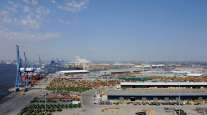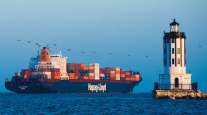Senior Reporter
Ports on West and East Coasts Show Sharp Decline in March

[Stay on top of transportation news: Get TTNews in your inbox.]
A steep, across-the-board decline in imported cargo, exports and empty containers during March dropped volumes at several major ports to levels not seen since before the COVID-19 pandemic.
The Port of Los Angeles processed 623,233 20-foot-equivalent containers, down 35% from last year’s 958,674.
“Economic conditions slowed global trade considerably in the first quarter; however, we are beginning to see some signs of improvement, including nine consecutive months of inflation declines,” Port of Los Angeles Executive Director Gene Seroka said. “While March cargo volume was lower than last year at this time, early data and monthly growth indicates a moderate increase in Q3.”
Seroka also announced that Volvo Trucks North America is working to collaborate with the port to bring zero-emission drayage trucks to the facility with the goal of having the entire drayage fleet be zero-emissions by 2035.
Trade at the Port of Long Beach in March declined nearly one-third from the same period last year. Dockworkers and terminal operators moved 603,878 TEUs last month, down 30% from March 2022, the Port’s busiest March on record. https://t.co/PTQLFfMWwV pic.twitter.com/Njlwy6rdWG — Port of Long Beach (@portoflongbeach) April 19, 2023
The adjacent Port of Long Beach also saw a significant decline in container volume in March. That was primarily due to retailers working on emptying warehouses of older inventory and shippers continuing to move more freight to East Coast ports because of concerns over the slow pace of labor talks between the Pacific Maritime Association and the International Longshore and Warehouse Union.
Long Beach saw a 30% decline from 2022 as the port processed 603,878 containers compared with 863,156.
“Warehouses remain full, and fewer cargo containers are crossing the docks because consumer spending remains slow,” Port of Long Beach Executive Director Mario Cordero said. “We are ready for a rebound in retail as we work with our industry partners to recapture market share.”
The Port of Oakland recorded a 12.3% decline in container volume, processing 170,268 containers in March compared with 194,205 year-over-year.
Las Vegas A’s…well…solves that.https://t.co/UnIjAyKNOQ via @sfchronicle — Matt Schrap (@mattschrap) April 20, 2023
While the port saw its container volumes decline, plans for a new home for Major League Baseball’s Oakland Athletics, as well as a multibillion-dollar entertainment and residential district inside the Port of Oakland complex, appear at a dead end.
The team on April 19 said it had entered a binding agreement to purchase 49 acres of land in Las Vegas to construct a 30,000- to 35,000-seat ballpark with a retractable roof.
“We’re focusing all our attention on Las Vegas now,” team President Dave Kaval said. “We were on those parallel paths for a while evaluating both sides, Oakland and Southern Nevada. But now we are fully focusing our attention on Las Vegas to finalize all the necessary approvals and the public-private partnership to allow us to file for relocation with Major League Baseball and to make our deadline, which is coming up in January of next year.”

Mike Furst of Volvo Trucks North America discusses a dealer-managed service plan that is paired with enhanced connectivity to cover all fleet preventative maintenance. Hear the program above and at RoadSigns.TTNews.com.
The A’s lease at Oakland Coliseum expires at the end of the 2024 season, and it’s not clear if the team would sign a short-term extension to stay in Oakland until a new ballpark is built in time for the 2027 season.
The Northwest Seaport Alliance, which operates ports in Seattle and Tacoma, Wash., saw a 37.3% cargo decrease in March.
Meanwhile, Seattle’s Terminal 5 this month welcomed the MSC Brunella as the first vessel to plug in to the terminal’s shore power infrastructure. Shore power infrastructure reduces diesel particulate matter and greenhouse gas emissions by allowing vessels to turn off their diesel engines and “plug in” to the local power grid while being worked at the dock.
The Port of Houston, which has been one of the fastest growing ports the past several years, saw container volumes dip 3% last month to 300,589 TEUs from 308,557 a year ago.
On the East Coast as well, all major port complexes reported declines year-over-year.
The Port of Savannah, Ga., reported a 17.2% decline, processing 367,880 TEUs compared with 444,690 in 2022.
“An important factor in current trade volumes are reduced orders from large general merchandise retailers as the companies work through overstocked inventories,” the port said in a statement. “Additionally, rising interest rates and reduced buying power caused by inflation have exerted downward pressure on consumer spending.”
The Port of Virginia said container volumes were down 21% in March as the port moved 248,815 TEUs compared with 314,698 a year earlier.

Melvin
The Port of Charleston, S.C., in March had a nearly 26% decline as it had its softest month in more than a year, processing 198,085 TEUs compared with 264,334 a year.
South Carolina Ports, meanwhile, celebrates the five-year anniversary of Inland Port Dillon with a record number of containers handled at the rail-served inland port in March.
“It was five years ago — almost to the day — that we were here opening this facility. What an accomplished five years we have had,” SC Ports CEO Barbara Melvin said. “It has been amazing to see the growth at Inland Port Dillon.
The Port Authority of New York and New Jersey reports its figures one month behind the other ports. In February, container volume slid 25% to 571,177 from 759,248 a year ago.
Want more news? Listen to today's daily briefing below or go here for more info:




